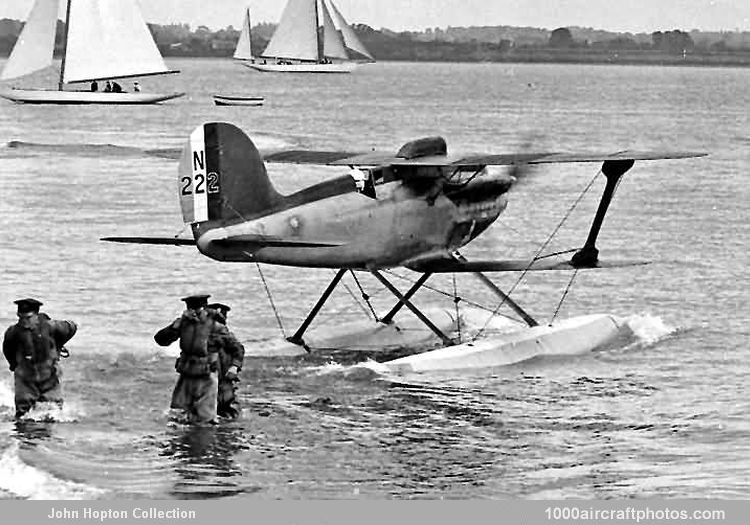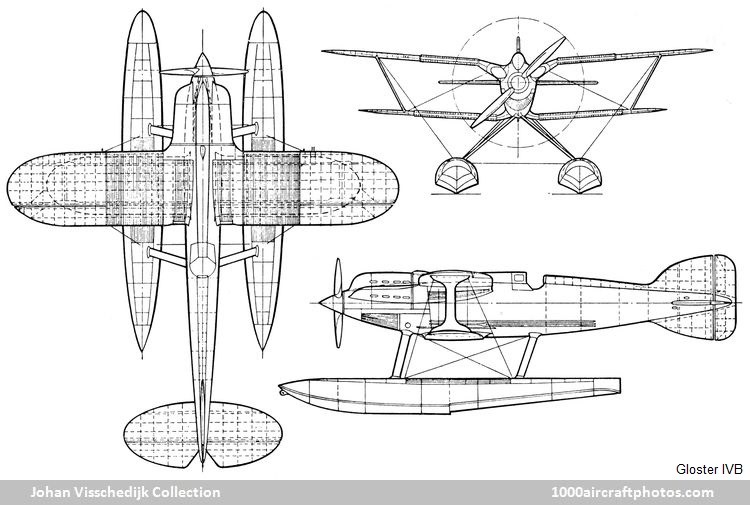12/15/2017. Remarks by Johan Visschedijk: "During the early weeks of 1926 Harry Folland, Gloster Aircraft Company's assistant designer began work on the design of a new high-speed floatplane to be built in readiness for the following year's Schneider contest in Venice, Italy. It was, again, a biplane in spite of the fact that the 1926 contest-winning Macchi M.39 and the S.5, then being created by Supermarine, were monoplanes. Folland remained unconvinced that in the tough Schneider contest conditions the sleeker monoplanes had any edge over the more robust biplane. His view was strengthened by the continued development of the Curtiss biplane racers in the United States.
Using the Gloster III design as a starting point, Folland and H. E. Preston, Gloster's assistant chief engineer and designer, gradually refined and redrew the fuselage lines and, by careful attention to the points where the various components joined, a 40% reduction in head resistance was achieved. The blending of the mainplane roots into the fuselage improved the drag characteristics and provided 15% more lift. These aerodynamic refinements plus an increase in engine power made the Gloster IV some 70 mph (113 kmh) faster than its predecessor.
The Gloster IV was a single-seat open-cockpit twin-float racing biplane of wood and metal construction with plywood covering. The pilot sat in an open cockpit. Three aircraft were ordered, designated Gloster IV, IVA and IVB and serialled N224, N222 and N223 respectively; each was slightly different. Because of the high efficiency of N224's mainplane, the other two aircraft had 4 ft (1.21 m) cropped from their span, effectively reducing the area by some 16%. The tail unit of N222 was redesigned to a cruciform shape with fin and rudder area above and below the tail plane.
N224 was powered by a 900 hp Napier Lion VIIA twelve-cylinder liquid-cooled direct-drive supercharged broad-arrow engine driving a 6 ft 9 in (2.05 m) diameter Gloster two-blade fixed-pitch metal propeller. N222 was fitted with the same propulsion system, only with a slightly larger propeller of 7 ft 0 in (2.13 m) diameter. N223 had an 885 hp geared Lion VIIB driving a 7 ft 8.5 in (2.34 m) diameter propeller.
All three aircraft were delivered to the High Speed Flight based at Calshot during July-August 1927 for preliminary flying which, once again, was of surprisingly short duration. N222 arrived on July 29 and was flown for only 40 min before being shipped with N223 to Venice on August 16. In Venice further practice flying by Flight Lieutenant S.M. Kinkead added only 72 min to N222's log book and barely 35 min to that of N223 – which was chosen to fly in the contest. During a flight on September 21 the spinner came off N223's propeller as it was alighting and damaged a blade, but the aircraft was quickly made serviceable. In the contest Kinkead lapped steadily at around 275 mph (442 kmh), but retired in the sixth lap after the Lion appeared to falter. Back in the hangar the propeller was removed, when it was discovered that the engine's splined propeller shaft was cracked three-quarters around its diameter.
This was the last appearance of a biplane in the Schneider Trophy series, but Gloster had the satisfaction of N223's third lap of 277.1 mph (445.94 kmh) which set an all-time record for biplane types.
On October 4 both aircraft were shipped to Felixstowe where they remained on test flying duties until February 21, 1928, when they returned to Gloster's factory for modification and conversion to trainers. To improve the pilot's forward view the upper mainplane was raised to fair directly into the top cylinder bank, and upper center section struts and an external header tank were fitted. N222 went back to Felixstowe in July and with N223 was flown by the 1929 Schneider team. In the following March both aircraft were back at the factory for changes in the tail unit to cure high-speed yaw. Although area was added to the dorsal fin it did not effect a cure, and a tail unit was fitted of the pattern used on N224 – which had never experienced this yawing-and longitudinal stability was recovered.
N224 was sold, in 1930, to Amherst Villiers who intended to convert it into a landplane, with a normally aspirated geared Lion engine, for an attempt on Bonnet's world speed record of 278.5 mph (448.19 kmh), but the plan did not mature. The other two aircraft were used regularly at Calshot and Felixstowe until on December 19, 1930, Flight Lieutenant J. Boothman crashed N223 while alighting in fog. N222 subsequently made 147 flights, a large number of them in developing the best technique for rounding pylons. It is reported that Kinkead also looped and rolled this aircraft."

